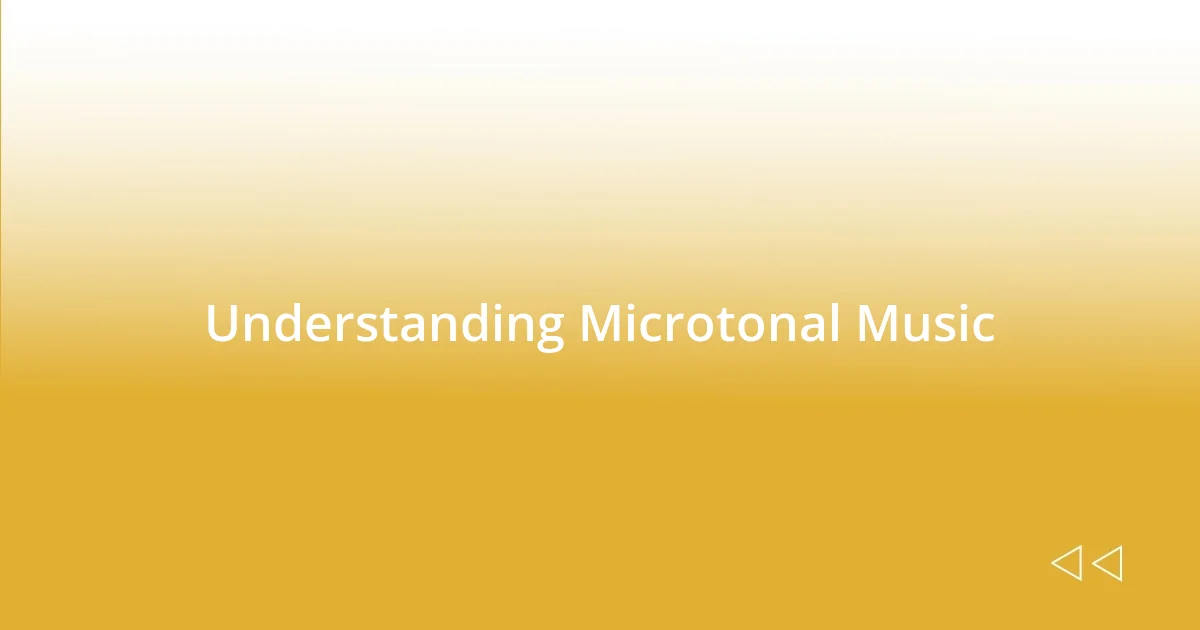Key takeaways:
- Microtonal guitar playing expands creative horizons by allowing musicians to explore intervals smaller than a semitone, leading to richer emotional expression.
- Selecting the right microtonal guitar involves considering factors like fret design, materials, neck width, and tuning stability to fully unlock unique sound potential.
- Improvisation and composition in microtonal music encourage spontaneity and experimentation, enhancing self-expression and collaboration with other musicians.

Introduction to Microtonal Guitar
Microtonal guitar playing opens a fascinating world of sound that many musicians often overlook. I remember the first time I experimented with microtonal scales; it felt like discovering a secret language of music that spoke to something deep within me. Have you ever felt that thrill when your fingers find just the right note in an unexpected place?
In microtonal music, traditional Western tuning gives way to a broader palette of intervals, allowing for more expressive melodies. When I first adjusted my guitar to play quarter tones, the richness of those notes captured my imagination. I was entranced by how a slight shift could transform a familiar melody into something entirely new and emotional.
Understanding microtonality can be a journey in itself. I felt a sense of liberation as I explored various tuning systems, each offering unique emotional textures. It prompted me to ask: how much do we limit ourselves by adhering strictly to standard tuning? From my experience, embracing microtonality not only expands creative horizons but also deepens our emotional connections to the music we create.

Understanding Microtonal Music
Microtonal music, unlike conventional Western music, uses intervals smaller than the typical semitone. When I first delved into these subtleties, it felt as though I had unlocked a hidden dimension of sound. I vividly recall a moment when I played a piece that incorporated microtones, and the audience’s reactions were a mesmerized blend of confusion and wonder. It was a powerful reminder that music can embody emotion far beyond the constraints of traditional notes.
As I became more familiar with microtonal scales, I discovered that different cultures approach tuning with varied philosophies. For instance, a Persian musician utilizes a system that emphasizes quarter tones, which has an eerie, whispering quality I find profoundly touching. Engaging with these diverse systems has challenged my perceptions of harmony and melody, inviting me to think more deeply about how I express emotion through my music.
To truly appreciate microtonal music, one must embrace its inherent complexity and richness. It’s fascinating to experiment with my guitar, adjusting the frets and creating nuances that evoke vivid feelings. This process has led me to appreciate not only the art of performance but also the artistry of composition, where every micro-interval can shift the emotional landscape of a piece.
| Microtonal Music | Traditional Western Music |
|---|---|
| Utilizes intervals smaller than a semitone | Based on whole and half steps |
| Emphasizes rich emotional expression | Follows established harmonic rules |
| Common in many global musical traditions | Predominantly Western-centric |

Selecting the Right Microtonal Guitar
Selecting the right microtonal guitar can feel overwhelming, but it’s critical for unlocking the full potential of your sound. I remember the excitement I felt when I found a guitar with adjustable frets. The flexibility to change the intervals allowed me to explore uncharted musical territory. It’s like having a key to a door that opens to a universe of unique tones just waiting to be discovered.
When considering which microtonal guitar to choose, here are some key factors to keep in mind:
- Fret Design: Look for guitars with adjustable or movable frets to facilitate microtonal playing.
- Materials: The wood type can significantly affect sound quality; lighter woods often produce a brighter tone.
- Neck Width: A wider neck can provide more space for finger placement, which is especially useful for microtonal scales.
- String Action: Low action can make playing easier, but be cautious—it may cause unwanted buzzing with microtonal bends.
- Tuning Stability: Ensure the guitar holds tuning well, as frequent adjustments can disrupt your flow when experimenting with microtonality.
Choosing a microtonal guitar is a personal journey that resonates with your unique style and vision. Each guitar tells its own story, and I often find myself connecting emotionally with the instruments I play, shaping the music I create.

Techniques for Microtonal Playing
Embracing techniques for microtonal guitar playing has been a transformative journey for me. One of the most powerful techniques I adopted is using finger bending and sliding. When I slide my fingers between frets, I create fluid transitions that evoke a sense of longing and emotion. Have you ever tried bending a note just enough to make it sing differently? The way a microtonal slide can suspend time, it’s as though you’re stretching the sound to unveil its hidden beauty.
Another key technique is experimenting with alternate tunings. I remember one session where I tuned my guitar to match a characteristically Persian scale. The moment I struck that first chord, I was transported; it felt like I had reconnected with an ancient musical lineage. Each tuning opens a new door, offering a unique palette of colors that often feels more expressive than standard tuning. Have you ever experienced that thrill of trying out a new tuning and discovering something entirely different about your playing?
Lastly, incorporating microtonal elements into improvisation can elevate your music to new heights. I’ve found that allowing myself to play freely, without the confines of traditional scales, opens up a whole new realm of creativity. It’s in those moments of spontaneous expression that I truly discover my voice. Have you let your intuition guide you in a similar way? It’s a liberating experience that can deepen your connection to your instrument, highlighting the endless possibilities that microtonal playing has to offer.

Creating Scales and Tunings
Creating microtonal scales and tunings has truly been an adventure for me. I remember my first attempt at crafting a custom scale based on the Hijaz Kar tune. As I adjusted the frets, finding the right intervals felt a bit like piecing together a puzzle. The moment I played my first few notes, I was filled with a sense of discovery that’s hard to describe—did I just unlock a new chapter in my musical journey?
One of my favorite methods involves using a digital tuner to visualize the microtonal intervals I create. It’s fascinating to see how just a slight adjustment can drastically alter the mood of a piece. When I first explored just intonation, I was amazed by how the pure intervals resonated—creating harmonies that felt almost sacred. Have you delved into this technique? I found that spending time fine-tuning my approach not only sharpened my skills but also deepened my emotional connection to the music.
As I continue to explore, I’ve realized the importance of keeping a journal of my scale experiments. I jot down the emotions each tuning evokes—sometimes it’s joy, other times profound melancholy. For instance, there was a scale I created that embodied a sense of longing; when I played it, it felt like distant memories were coming alive. Tracking these experiences has turned my creative process into a dialogue with myself. Have you ever documented your musical explorations? If so, you might find that understanding the emotional aspects enhances your overall experience as much as the technical skills do.

Improvisation with Microtonal Music
Improvising with microtonal music has become a profound means of self-expression for me. I vividly remember a moment during an impromptu jam session where my fellow musicians and I decided to forgo the traditional 12-tone scales. As I played through the nuances of a Raga-inspired scale, I felt as though I was weaving together threads of my emotions—each note emerging as a heartfelt whisper rather than just a sound. Have you ever found yourself lost in the notes, feeling as if each one is telling a part of your story?
What really excites me about microtonal improvisation is how it encourages spontaneity. I often find myself drawn to unexpected intervals that challenge my ear. There was a night I picked up my guitar, and instead of sticking to familiar patterns, I embraced a completely free form. The melodies that flowed felt almost like a conversation with the universe. Was it scary? Absolutely—but that unpredictability is where the magic happens. Do you remember the last time you let your intuition completely dictate your music?
I’ve also discovered that microtonal improvisation deepens collaboration with other musicians. When jamming, I love the way our styles blend, creating intricate tapestries of sound. One memorable collaboration was with a keyboardist who explored just intonation alongside me. As we shifted through various microtones, our musical dialogue became a living entity that shifted and evolved right before our eyes. Did you ever experience that thrilling synergy with another artist? Those moments when everything aligns are not just fulfilling; they redefine how we understand our own musical pathways.

Tips for Composing Microtonal Pieces
Exploring unconventional tunings can significantly enhance your compositions. I remember one particularly inspired night when I experimented with a Pythagorean tuning. The tension in the intervals brought a captivating layer to a piece I thought was complete. Have you ever had that moment of realization where a simple change opens up an entirely new dimension to your music?
Consider incorporating unique rhythmic patterns alongside microtonal scales to create a richer texture. I once paired a 7/8 time signature with a microtonal scale, and the result was mesmerizing—each note felt like it was dancing in syncopation, adding a layer of unpredictability to the rhythm. It’s in those offbeat moments that I found a sense of freedom. What unique combinations have you tried that surprised you?
Lastly, don’t shy away from utilizing technology to shape your compositional voice. I often use software that allows me to map out microtonal intervals visually. It’s like having a personal guide as I navigate complex harmonic territories. This not only helps in solidifying my ideas but also sparks new ones. Have you ever stumbled upon a tool that radically transformed your creative process? The right technology can be the bridge that takes your compositions from good to extraordinary.














